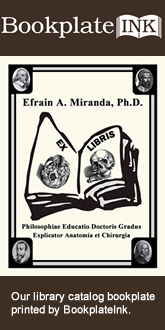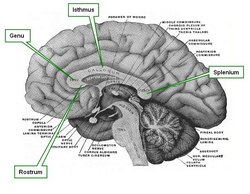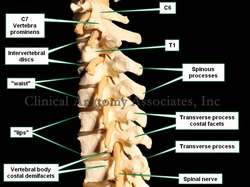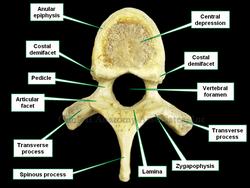
Medical Terminology Daily (MTD) is a blog sponsored by Clinical Anatomy Associates, Inc. as a service to the medical community. We post anatomical, medical or surgical terms, their meaning and usage, as well as biographical notes on anatomists, surgeons, and researchers through the ages. Be warned that some of the images used depict human anatomical specimens.
You are welcome to submit questions and suggestions using our "Contact Us" form. The information on this blog follows the terms on our "Privacy and Security Statement" and cannot be construed as medical guidance or instructions for treatment.
We have 2263 guests online

Georg Eduard Von Rindfleisch
(1836 – 1908)
German pathologist and histologist of Bavarian nobility ancestry. Rindfleisch studied medicine in Würzburg, Berlin, and Heidelberg, earning his MD in 1859 with the thesis “De Vasorum Genesi” (on the generation of vessels) under the tutelage of Rudolf Virchow (1821 - 1902). He then continued as a assistant to Virchow in a newly founded institute in Berlin. He then moved to Breslau in 1861 as an assistant to Rudolf Heidenhain (1834–1897), becoming a professor of pathological anatomy. In 1865 he became full professor in Bonn and in 1874 in Würzburg, where a new pathological institute was built according to his design (completed in 1878), where he worked until his retirement in 1906.
He was the first to describe the inflammatory background of multiple sclerosis in 1863, when he noted that demyelinated lesions have in their center small vessels that are surrounded by a leukocyte inflammatory infiltrate.
After extensive investigations, he suspected an infectious origin of tuberculosis - even before Robert Koch's detection of the tuberculosis bacillus in 1892. Rindfleisch 's special achievement is the description of the morphologically conspicuous macrophages in typhoid inflammation. His distinction between myocardial infarction and myocarditis in 1890 is also of lasting importance.
Associated eponyms
"Rindfleisch's folds": Usually a single semilunar fold of the serous surface of the pericardium around the origin of the aorta. Also known as the plica semilunaris aortæ.
"Rindfleisch's cells": Historical (and obsolete) name for eosinophilic leukocytes.
Personal note: G. Rindfleisch’s book “Traité D' Histologie Pathologique” 2nd edition (1873) is now part of my library. This book was translated from German to French by Dr. Frédéric Gross (1844-1927) , Associate Professor of the Medicine Faculty in Nancy, France. The book is dedicated to Dr. Theodore Billroth (1829-1894), an important surgeon whose pioneering work on subtotal gastrectomies paved the way for today’s robotic bariatric surgery. Dr. Miranda.
Sources:
1. "Stedmans Medical Eponyms" Forbis, P.; Bartolucci, SL; 1998 Williams and Wilkins
2. "Rindfleisch, Georg Eduard von (bayerischer Adel?)" Deutsche Biographie
3. "The pathology of multiple sclerosis and its evolution" Lassmann H. (1999) Philos Trans R Soc Lond B Biol Sci. 354 (1390): 1635–40.
4. “Traité D' Histologie Pathologique” G.E.
Rindfleisch 2nd Ed (1873) Ballieres et Fils. Paris, Translated by F Gross
"Clinical Anatomy Associates, Inc., and the contributors of "Medical Terminology Daily" wish to thank all individuals who donate their bodies and tissues for the advancement of education and research”.
Click here for more information
- Details
The term [corpus callosum] is Latin. The word [corpus] means "body", while the term [callosum] derives from [callosus] meaning "callous" or a structure with a hard consistency.
The corpus callosum is the largest of the nine interhemispheric commisures of the brain. It is formed by white matter consisting of axons that communicate both cerebral hemispheres. The corpus callosum is formed by several components:
• Rostrum: an anteroinferior region that resembles a bird's beak
• Genu: Latin for "knee", the genu is formed mostly by interfrontal fibers. These fibers form the anterior fornix
• Isthmus:also known as the "body" or "trunk", it is the main portion of the corpus callosum, allowing for interparietal and intertemporal communication
• Splenium: Latin for "bandage" the splenium allows for interhemispheric communication between the parietal, temporal, and occipital lobes. The fibers of the splenium form the posterior fornix
The image shown is a median section of the brain. Click on the image for a larger depiction. For a superior view of the corpus callosum click here.
Sources:
1 "Tratado de Anatomia Humana" Testut et Latarjet 8 Ed. 1931 Salvat Editores, Spain
2. "Anatomy of the Human Body" Henry Gray 1918. Philadelphia: Lea & Febiger
Image modified by CAA, Inc, Original image courtesy of bartleby.com
- Details
The term [vertebra prominens] is Latin and means the "prominent vertebra". It refers to the seventh cervical vertebra (C7) because of its long spinous process. Because of the anterior lordotic curvature of the cervical spine, their short spinous processes, and the presence of the ligamentum nuchae, the cervical vertebrae are usually not palpable with the exception of the vertebra prominens.
If you slide a finger down the nape of your neck in the midline, the first "bump" that is felt in the spine is the vertebra prominens, the next one down is T1, and so forth.
The vertebra prominens has foramina transversaria as do all cervical vertebrae. The only difference is that the vertebral artery usually is not found in the C7 foramina, opposite of the rest of the cervical vertebrae. The vertebral veins do pass through the foramina transversaria of the vertebra prominens.
Image property of: CAA.Inc. Photographer: David M. Klein
- Details
The root terms [-corp-] and [-corpor-] both arise from the Latin word [corpus] which means "body". The term corpus is used in human anatomy with the same meaning. Examples are:
• corpus vertebrale: The corpus or body of a vertebra
• corpus gastricum: The corpus or body of the stomach
• corpus callosum: A thick structure in the brain that communicates the cerebral hemispheres across the midline
The plural form is [corpora] as in the corpora cavernosa a pair of erectile bodies in the human genitalia.
In English both these roots can be found in words such as corpse, corporation, corporal, corpulent, corpuscle, etc.
- Details
The word [fundus] is Latin and originally means "bottom", "base", or "foundation". The English root term [-found-] is derived from fundus in words such as "founder", "foundation", and "profound", as in "bottomless". Another derived root is [-fund-] with the meaning of "base capital".
Further evolution of the term lead to ancillary meaning of the term [fundus] as "pocket" as in the "bottom of a pocket". In fact, even today in Spanish, one of the word for "pocket" is "fundillo". This is the meaning that is used in human anatomy.
A fundus is a pocket-like segment or extension of an organ, such as the fundus of the stomach, the fundus of the gallbladder or the fundus of the uterus.
- Details
This article is part of the series "A Moment in History" where we honor those who have contributed to the growth of medical knowledge in the areas of anatomy, medicine, surgery, and medical research.
Prof. Dr. Eric Mühe (1938 - 2005) Much has been written about who gets the glory of having performed the first laparoscopic cholecystectomy. Many famous names are in the annals of Surgery listed as pioneers in this field: Perissat, Berci, Mouret, Dubois, Sepulveda, Reddick, McKernan, Saye, Lizana, and others. Prof. Dr. Eric Mühe was usually not mentioned, but there is no doubt that on September 12, 1985, Dr. Mühe performed a laparoscopic cholecystectomy using a device of his own design (Galloscope) which lifted the anterior abdominal wall, maintained pneumoperitoneum, and doubled as a laparoscope.
Dr. Mühe was an avid cyclist and built and repaired his own bicycles. He once told me that he was looking at bicycle metal tube, and when looking through it, he thought that he could obtain access to the abdomen and the gallbladder with minimal changes. I am privileged to have known him and I was sad to learn that he passed in 2005. Dr. Miranda
For more information in downloadable PDF format: CLICK HERE, or HERE
- Details
The [transverse processes] are two lateral bony processes found in most vertebrae, with the exception of the coccygeal vertebrae.
Transverse processes have regional variations. The transverse processes in the cervical vertebrae are heavily modified with anterior and posterior roots forming the boundaries of the foramina transversaria. They are "gutter-shaped" to accommodate the spinal nerves, and angled at 60 degrees anteriorly with a 15 degree inferior tilt.
In the thoracic region the transverse processes point posterolaterally and present with an articular facet (costal facet) for the costal tubercle of a rib, forming the costotransverse joint. The transverse processes of T11 and T12 do not have a costal facet.
The transverse processes in the lumbar region point slightly posterolateral, and they are larger. The longest transverse processes in the lumbar region are those of L3. The transverse processes of L5 are atypical in that they also point superolaterally at almost 45 degrees. This is because these transverse processes are attached to the posterior superior iliac spine and iliac crest by the iliolumbar ligament, contributing to the prevention of forward displacement of L5 over S1.
The sacral transverse processes contribute to the larger mass of the sacrum fusing to form the intermediate sacral crest on its posterior surface.
Thanks to Dr. Mary M Tuchscherer for her comments and improvement of this article.
Image property of: CAA.Inc. Photographer: David M. Klein





